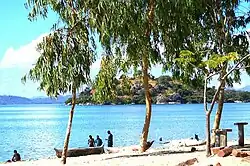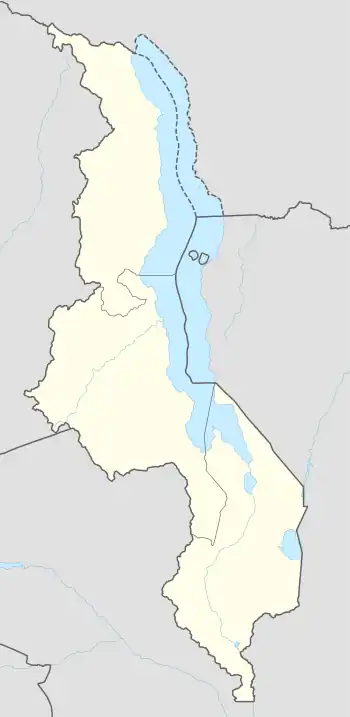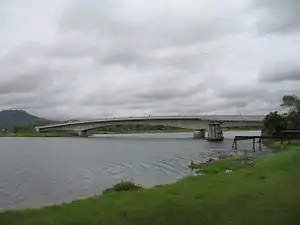Mangochi | |
|---|---|
 Lake Malawi, on eastern edge of Mangochi | |
 Mangochi Location in Malawi | |
| Coordinates: 14°27′36″S 35°16′12″E / 14.46000°S 35.27000°E | |
| Country | |
| Region | Southern Region |
| District | Mangochi District |
| Elevation | 1,541 ft (470 m) |
| Population (2018 Census[1]) | |
| • Total | 53,498 |
| • Languages | Yao |
| Time zone | +2 |
| Climate | Aw |
Mangochi is a township in the Southern Region of Malawi. Located near the southern end of Lake Malawi, in colonial times it used to be called Fort Johnston. As of 2018 it has a population of 53,498.[1]
History
Mangochi was founded by colonial administrator Sir Harry Johnston in the 1890s as a British colonial defence post on the littoral plain of the Shire River's western shore.[2] After this, Fort Johnston – as the town was then known – was an important slave market and administrative centre.[3]
The British gunboat Gwendolen, named after Lady Gwendolen Gascoyne-Cecil, daughter of the 3rd Marquess of Salisbury,[4] was built in Mangochi in 1897.[3][5] At 310 tonnes (340 short tons), it was the largest ship to sail on Lake Malawi until being scrapped shortly after World War II.[3] The gunboat, operated by the Protectorate of Nyasaland, is said to have fought the first naval battle of the First World War when it defeated the German vessel Hermann von Wissmann in August 1914.[6]
Rioting in June 2003 injured three people.[7] From March to November 2007, roughly 480 children were rescued from child labour on tobacco farms in Mangochi.[8] In July 2008, elephants terrorised areas around Maldeco Fisheries in Mangochi and caused several deaths and damage to property, mainly crops.[9] The Ministry of Tourism, Wildlife and Culture proposed moving the elephants into several game reserves, although the proposal stalled when some residents said they wanted the elephants to remain.[9]
Geography

Mangochi is at an elevation of 470 m (1,541 ft), near the southern end of Lake Malawi, between the main lakeshore road and the Shire River[3] and 8 kilometres (5 miles) south of its entrance into Lake Malombe.[2] The town is roughly 190 km (120 mi) northeast of Blantyre, Malawi's largest city.[7] It is situated 2.2 km (1+3⁄8 mi) from Mponda, 3.6 km (2+1⁄4 mi) from Chipalamawamba, 3 km (2 mi) from Mbaluku Laini and 2.2 km (1+3⁄8 mi) from Yangala.
Climate
Mangochi has a tropical savanna climate (Köppen: Aw).
| Climate data for Mangochi | |||||||||||||
|---|---|---|---|---|---|---|---|---|---|---|---|---|---|
| Month | Jan | Feb | Mar | Apr | May | Jun | Jul | Aug | Sep | Oct | Nov | Dec | Year |
| Mean daily maximum °C (°F) | 30.1 (86.2) |
30.0 (86.0) |
30.2 (86.4) |
29.5 (85.1) |
28.1 (82.6) |
26.5 (79.7) |
26.3 (79.3) |
28.3 (82.9) |
31.4 (88.5) |
33.6 (92.5) |
33.2 (91.8) |
31.0 (87.8) |
29.9 (85.8) |
| Daily mean °C (°F) | 25.5 (77.9) |
25.4 (77.7) |
25.3 (77.5) |
24.3 (75.7) |
22.1 (71.8) |
20.3 (68.5) |
20.1 (68.2) |
21.8 (71.2) |
24.5 (76.1) |
26.9 (80.4) |
27.3 (81.1) |
26.1 (79.0) |
24.1 (75.4) |
| Mean daily minimum °C (°F) | 21.6 (70.9) |
21.5 (70.7) |
21.1 (70.0) |
19.8 (67.6) |
16.7 (62.1) |
14.2 (57.6) |
14.3 (57.7) |
15.4 (59.7) |
17.8 (64.0) |
20.8 (69.4) |
22.0 (71.6) |
22.0 (71.6) |
18.9 (66.0) |
| Average precipitation mm (inches) | 194.2 (7.65) |
200.8 (7.91) |
144.0 (5.67) |
36.6 (1.44) |
5.7 (0.22) |
4.4 (0.17) |
3.9 (0.15) |
1.5 (0.06) |
3.0 (0.12) |
15.9 (0.63) |
64.2 (2.53) |
172.0 (6.77) |
846.2 (33.31) |
| Average precipitation days (≥ 0.3 mm) | 16 | 14 | 13 | 6 | 2 | 2 | 2 | 2 | 1 | 2 | 7 | 14 | 81 |
| Average relative humidity (%) | 78 | 78 | 76 | 73 | 60 | 66 | 62 | 57 | 50 | 50 | 59 | 72 | 65 |
| Mean monthly sunshine hours | 204.6 | 187.6 | 238.7 | 252.0 | 279.0 | 255.0 | 257.3 | 279.0 | 288.0 | 300.7 | 258.0 | 207.7 | 3,007.6 |
| Mean daily sunshine hours | 6.6 | 6.7 | 7.7 | 8.4 | 9.0 | 8.5 | 8.3 | 9.0 | 9.6 | 9.7 | 8.6 | 6.7 | 8.2 |
| Source: NOAA[10] | |||||||||||||
Demographics
Population development
| Year | Population[11][1] |
|---|---|
| 1977 | 3,341 |
| 1987 | 14,758 |
| 1998 | 26,570 |
| 2008 | 39,575 |
| 2018 | 53,498 |
| Year | Pop. | ±% p.a. |
|---|---|---|
| 1977 | 3,341 | — |
| 1987 | 14,758 | +16.02% |
| 1998 | 26,570 | +5.49% |
| 2008 | 39,575 | +4.06% |
| 2018 | 53,498 | +3.06% |
| source:[12] | ||
Languages and ethnicities
Yao, specifically the Mangochi dialect, is the main language spoken in this town.[13] A Swahili settlement was also established in Mangochi.[14] Mangochi is mainly inhabited by the Yao people.[2]
Economy
Mangochi was developed as an agricultural centre and has marine-engineering shops. Cash crops grown in the area include tobacco, cotton, and groundnuts.[2] Rice and maize are intensively grown along the lakeshore, and commercial fishing is also important.[2]
Facilities
Amenities
Amenities include several shops, supermarkets, a post office and banks.[3]
Bridges

Within Mangochi there is the Bakili Muluzi Bridge, which Lonely Planet described as "scenic".[3]
Museums
The Lake Malawi Museum houses ethnic, environmental, and historical exhibits.[3] They include the Hotchkiss gun[3] with which the British gunboat Gwendolen defeated the German gunboat Hermann von Wissmann with a single shot in their brief naval engagement in August 1914. The museum has also a scale model of the Gwendolen.[3] An even older exhibit is a marine steam engine that was built in 1898 and powered the Universities' Mission to Central Africa's SS Chauncy Maples until 1953.[15]
Religion
Mangochi is home to a large mosque[3] as well as a modern Catholic Cathedral.[16]
Clocks
Mangochi is home to a clock tower erected in honour of Queen Victoria, dating back to the early 20th century.[16]
Transport

Mangochi is located just off the M3 road.[16] All buses travelling from Monkey Bay to Blantyre stop in Mangochi.[3] Minibuses travel to Liwonde, Zomba, and Blantyre.[3] Matolas travel to Liwonde National Park and to the border town of Chiponde.[3]
Tourism
Mangochi is described by Lonely Planet as having a "vaguely Swahili feel", with "palm trees, Arab-looking people and coconuts for sale in the street."[3] There are several guesthouses and lodges for tourists in Mangochi.[3]
References
- 1 2 3 "2018 Population and Housing Census Main Report" (PDF). Malawi National Statistical Office. Retrieved 25 December 2019.
- 1 2 3 4 5 "Mangochi". Encyclopædia Britannica. 2008. Retrieved 18 July 2008.
- 1 2 3 4 5 6 7 8 9 10 11 12 13 14 15 Murphy, Alan; Armstrong, Kate; Firestone, Matthew D.; Fitzpatrick, Mary (2007). Lonely Planet Southern Africa: Join the Safari. Lonely Planet. p. 205. ISBN 1-74059-745-1.
- ↑ Janie Hampton, "Victory on Lake Nyasa", History Today, vol 64, no. 7, 2014]
- ↑ Jane, Frederick Thomas (1919). Jane's Fighting Ships of World War I. Military Press. p. 101.
- ↑ The Story of the Rhodesias and Nyasaland A. J. Hanna Faber and Faber, 1960
- 1 2 "Soldiers Sent To Help Quell Riots in Malawi". The New York Times. 29 June 2003. Retrieved 17 July 2008.
- ↑ "Attitudes to Child Labour Changing". UN Integrated Regional Information Networks. AllAfrica. 19 November 2006. Retrieved 17 July 2008.
- 1 2 Msiska, Karen (7 July 2008). "Mangochi against removal of elephants". The Daily Times. Retrieved 18 July 2008.
- ↑ "Mangochi Climate Normals 1961–1990". National Oceanic and Atmospheric Administration. Retrieved 8 March 2015.
- ↑ "World Gazetteer: Malawi: largest cities and towns and statistics of their population". World Gazetteer. Archived from the original on 27 September 2007. Retrieved 17 July 2008.
- ↑ Malawi: Cities, Towns & Urban Localities
- ↑ Baldauf, Richard B.; Kaplan, Robert (2004). Language Planning and Policy in Africa: Botswana, Malawi, Mozambique and South Africa. pp. 85–89. ISBN 1-85359-725-2.
- ↑ Baldauf, p. 91
- ↑ "The Ship". Chauncy Maples, Lake Malawi's Clinic. Chauncy Maples Trust. 2009–2011. Archived from the original on 16 March 2012. Retrieved 28 July 2011.
- 1 2 3 "Mangochi". Malawi Tourism. Archived from the original on 20 July 2008. Retrieved 18 July 2008.